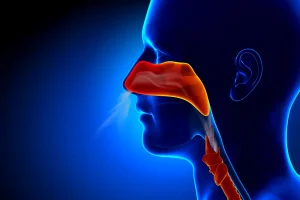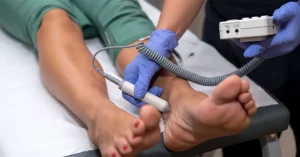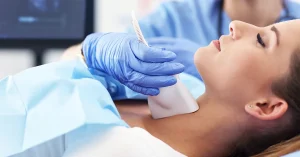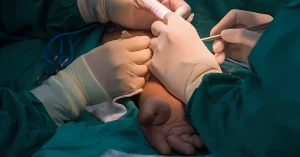Rhinoseptoplasty surgery is a minimally invasive procedure performed both for cosmetic enhancement and to improve nasal breathing. It combines rhinoplasty, which alters the external appearance of the nose, with septoplasty, which corrects internal structural issues. A rhinoseptoplasty is often recommended when both aesthetic concerns and functional problems are present. Surgeons frequently suggest addressing both in a single procedure for optimal results.
What Is Rhinoplasty?
Rhinoplasty is a surgical procedure designed to reshape the nose. Patients may seek rhinoplasty for cosmetic reasons, to enhance facial harmony, or for medical purposes such as correcting breathing difficulties. The upper portion of the nose consists of bone, while the lower part is cartilage. Rhinoplasty can modify bone, cartilage, skin, or all three, and may also address issues like a deviated septum.
When Is Rhinoplasty Recommended?
Rhinoplasty is recommended for altering the nose’s size, shape, or proportions. It may be indicated after trauma, to correct congenital deformities, or to address breathing difficulties. The surgery helps restore function and symmetry. Individuals experiencing one or more of these issues may benefit from rhinoplasty.
What Is Septoplasty?
Septoplasty is a surgical procedure performed to straighten the nasal septum, the structure made of bone and cartilage that separates the two nostrils. When the septum is deviated or crooked, it can obstruct airflow and lead to difficulty breathing through the nose. This condition also increases the risk of sinus infections due to impaired drainage.
During septoplasty, the surgeon repositions the septum to the center of the nasal cavity to restore proper airflow. The procedure may involve removing or reshaping parts of the septal bone and cartilage before placing them back in the correct position. Your surgeon will evaluate your symptoms and anatomy to determine if septoplasty is the appropriate treatment for you.
When Is Septoplasty Recommended?
Septoplasty is advised for individuals with a significantly deviated septum that impairs nasal airflow. A severe deviation can block one or both nostrils and negatively affect breathing. The procedure improves airflow by trimming, adjusting, or replacing cartilage and bone. If breathing issues reduce your quality of life, surgery should be considered.
Can I Have Rhinoplasty and Septoplasty at the Same Time?
Yes, both procedures can be performed simultaneously in what is known as a rhinoseptoplasty. Many plastic surgeons recommend combining them if both cosmetic and functional concerns exist. This approach avoids multiple surgeries and accelerates recovery. It also allows for more comprehensive results.What Is Rhinoseptoplasty Surgery?
Rhinoseptoplasty addresses both nasal appearance and breathing function. The surgery reshapes nasal bones and cartilage while straightening the septum. The septum, composed of bone and cartilage, divides the nasal cavity. By correcting both internal and external nasal structures, this surgery offers complete nasal correction.
What Are the Benefits of Rhinoseptoplasty?
- Achieve a desired nose shape and size.
- Noticeably improved breathing through both nostrils.
- Reduction or elimination of snoring lowers the risk of hypertension, cardiovascular disease, and stroke.
Following surgery, most incisions heal quickly, and breathing often improves within days. Swelling generally decreases within weeks, though full recovery may take several months. Cartilage and tissues typically stabilize over three to six months. Final changes may continue for up to a year after surgery.
Patients report benefits such as better sleep, reduced snoring, easier breathing, enhanced facial balance, and greater self-confidence.
How Is Rhinoseptoplasty Surgery Performed?
Rhinoseptoplasty is usually done under general anesthesia and lasts between one and two hours. The surgeon makes an incision inside the nasal mucosa and lifts it to access cartilage and bone. Deviated segments are removed or repositioned to straighten the septum.
To refine the nasal tip, the surgeon may excise excess cartilage. The nasal bones may be narrowed and aligned through controlled fractures. If needed, cartilage or bone grafts—or synthetic implants—are used to reinforce or rebuild nasal structures. Internal nasal packing may be placed to control bleeding, along with external splints for support.
How Long Does It Take to Recover from Rhinoseptoplasty?
After awakening from anesthesia, patients are monitored for several hours to detect complications like pain, fever, or bleeding. Full recovery may take up to two weeks. Doctors recommend avoiding work, crowds, and public gatherings during this time to reduce the risk of respiratory infections.
Strenuous activity, hot showers, and bending over are also discouraged. Most swelling and bruising resolve by the third week. However, the nose may take months to achieve its final shape.
What Complications Can Rhinoseptoplasty Surgery Have?
Some complications may be serious and should be recognized and addressed promptly.
1. General Complications:
- Pain
- Bleeding
- Surgical site infection
- Blood clots in the legs or lungs
2. Specific Complications:
- Adhesions inside the nasal cavity obstructing airflow
- Redness, bruising, and swelling around the nose and eyes
- Bleeding from infection
- Unsightly or visible scars
- Hematoma or abscess formation within the septum
- Nerve damage at the nasal tip
- Nasal blockage or persistent congestion
- Septal perforation (hole in the septum)
- Toxic shock syndrome
- Dissatisfaction with cosmetic results
- Graft rejection or failure
- Diminished sense of smell











